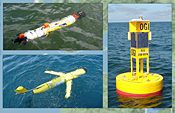You are here
EBS 566/666: Estuary and Ocean Systems II
Location: Wilson Clark Center 407
Syllabus: www.stccmop.org/files/EOSII_Syllabus_010410.pdf
1/04 Lecture 1: Introduction to ocean observatories I
- Course logistics
- National context
- The SATURN collaboratory (1/2)
Class notes: www.stccmop.org/files/EBS566_lect1_0.ppt
1/06 Lecture 2: Introduction to ocean observatories II
-The SATURN collaboratory (2/2)
Discussion: Hickey et al. 2010
Double space with figures: www.stccmop.org/files/Hickeyetalwithfigs_0.pdf
Single space, text only: www.stccmop.org/files/HickeyetalApr09_textonly_singlespace_0.doc
Class notes: www.stccmop.org/files/EBS566_lect2.ppt
1/11 Lecture 3: Descriptive estuarine and plume circulation I
- Tides
- Salinity intrusion
- Vertical stratification
- Residual circulation
Class notes: www.stccmop.org/files/EBS566_lect3.ppt
1/13 Lecture 4: Descriptive estuarine and plume circulation II
- Estuarine turbidity maxima
- Plume dynamics
- Internal waves
- Estuarine classification
Discussion: Chawla et al. 2008
www.stccmop.org/files/Chawlaetal_estuaries_2007_revised_springer_0.pdf
Class notes: www.stccmop.org/files/EBS566_lect4.ppt
- Concept: from A to Z
- Governing equations
Discussion: Nash and Moum 2005 mixing.coas.oregonstate.edu/papers/nature03936.pdf
Class notes: TBA
- Numerical algorithms
- Skill assessment
Class notes: www.stccmop.org/files/EBS566_lect6.ppt
1/27 Lecture 7: Evaluation for Part 1 of course
- In-class presentation of web pages for team assigment (30min per team)
- Take-home exam (24h):
(a) read ahead: www.stccmop.org/files/PlumeFormationKB.pdf
(b) exam: www.stccmop.org/files/Exam.doc. Due by e-mail on Jan 29 2010, at 8:00AM.
2/1 Lecture 8: Energy flow and trophic pathways
-Light in the aquatic environment
-Energy transfer and food webs
Class ppt: files/u152/EBS566_Lecture8.pdf
Updated slides: files/images/EBS566_Lecture8_update(1).pdf
WET Labs AC-S meter poster: files/u152/AC-S_Wetlabs.pdf
Suppl. notes on optics: files/u152/Notes_optics.doc
Supplemental readings (not required):
Smith & Baker (1978): files/u152/Smith_Baker_1978.pdf
Morel & Smith (1974): files/u152/Morel_Smith_1974.pdf
2/3 Lecture 9: Bacteria and Archaea in the Oceans
Class pdf: Lecture 9 bact/arch
Assigned reading: Chapter 5, Miller
Discussion paper: Martens-Habbena et al. Ammonia oxidation kinetics determine niche separation of nitrifying Archaea and Bacteria. Nature (2009) vol. 461 (7266) pp. 976-979
2/8 Lecture 10: Benthic Habitats and Organisms
Class pdf: Lecture 10 benthic
Assigned reading: Chapter 12, 14, Miller
Discussion paper (will be discussed on 2/10): Wishner et al. Involvement of the oxygen minimum in benthic zonation on a deep seamount. Nature (1990) pp. 57-59
Supplemental readings (not required, but if you weren't in class I suggest you read at least one of the articles):
Chapter 13, Miller
2/10 Lecture 11: Discussion of Wishner, et al. article, Video: Discovery 195, introduction to midwater animals
2/17 Exam: Take home exam. No class to allow time to work on the exam.
Exam 2
Updated Exam 2 (2/17/2010) - the scale bar in Figure 1 has been modified.
Due Weds. 2/24 3 pm, email to Margo. The exam is intended to take about 2 hours to complete, after any necessary review of materials. The long window for completion is to accommodate students participating in the Ocean Sciences meeting and other activities.
2/22 Lecture 12: Pelagic Habitats and Organisms, Bioluminescence
Class pdf: Pelagic
Class pdf: Bioluminescence
Assigned reading: Miller, Ch. 6, 11
Article for discussion: Robison et al. Giant Larvacean Houses: Rapid Carbon Transport to the Deep Sea Floor. Science (2005) vol. 308 (5728) pp. 1609
Supplementary reading: Miller Ch. 9-10
2/24 Lecture 13: Fish and Fisheries
Class pdf
Assigned reading: Miller, Ch. 15
Article for discussion: Christensen and Richardson. Stable isotope evidence of long-term changes in the North Sea food web structure. Mar Ecol Prog Ser (2008) vol. 368 pp. 1-8
Supplementary articles:
Krkošek et al. Epizootics of wild fish induced by farm fish. Proceedings of the National Academy of Sciences (2006) vol. 103 (42) pp. 15506
National Research Council. Marine Protected Areas: Tools for Sustaining Ocean Ecosystem . (2001) pp. 1-26
3/1 Lecture 14: Introduction to phytoplankton
Class notes: Lecture 14
Assigned reading: Miller, Ch. 1
Article for discussion: Townsend et al. (1992). Spring phytoplankton blooms in the absence of vertical water column stratification, Nature, 360: 59-62.
Supplementary article:
Sverdrup (1953). On Conditions for the the Vernal Blooming of Phytoplankton, ICES J. Mar. Sci. 18 (3): 287-295.
3/3 Lecture 15: Primary production and phytoplankton groups
Class notes: Lecture 15
Assigned reading: Miller, Ch 2
Supplemental reading: Adl et al. (2005). The New Higher Level Classification of Eukaryotes with Emphasis on the Taxonomy of Protists, J. Eukaryot. Microbiol., 52(5), pp. 399–451.
Assignment #2. Due March 9th (5 pm)
3/8 Lecture 16: Zooplankton
Class notes: Lecture 16
Assigned reading: Miller, Ch. 7
Article for discussion: Beaugrand et al. (2003). Plankton effect on cod recruitment in the North Sea, Nature, 426:661-664.
3/10 Lecture 17: Biological-physical coupling
Class notes: Lecture 17
Assigned reading: Miller, Ch. 7
Article for discussion in Monday's class (3/15) : Benitez-Nelson et al. (2007). Mesoscale Eddies Drive Increased Silica Export in the Subtropical Pacific Ocean, Science, 316: 1017-1021.
3/15 Lecture 18: Class discussion, review for exam, course wrap-up.
Assignment:
Many studies use bulk properties such as chlorophyll a or carbon biomass to describe the temporal or spatial characteristics of a system. Other studies go beyond bulk characteristics and examine the particular nature of organisms within a system. Is it worth the extra effort? Why would knowing the type of planktonic community (size, trophic level, pigments, species, etc.) present in an ecosystem matter in the big picture? Feel free to use examples from the literature to support your ideas.
One example is: Buesseler et al. (2007). Revisiting Carbon Flux Through the Ocean's Twilight Zone, Science, 316: 567-570.
3/17 Exam #3.
Click here for a list of potential exam questions.
From this list, 4 will appear on the exam. You will be asked to answer 3 of the 4 presented on the exam.






